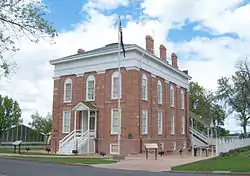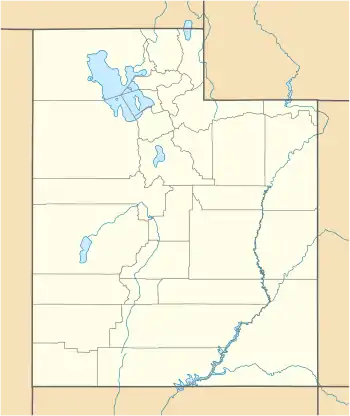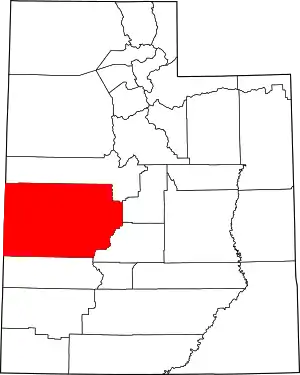Fillmore, Utah
Fillmore is a city and the county seat of Millard County, Utah, United States.[5] The population was 2,435 at the 2010 United States Census. It is named for the thirteenth US President Millard Fillmore, who was in office when Millard County was created by the Utah Territorial legislature.[6][7]
Fillmore, Utah | |
|---|---|
 Utah Territorial Statehouse | |
 Location in Millard County and the state of Utah | |
 Fillmore Location in Millard County and the state of Utah  Fillmore Fillmore (the United States) | |
| Coordinates: 38.967778°N 112.33083°W | |
| Country | |
| State | |
| County | Millard |
| Founded | 1851 |
| Named for | Millard Fillmore |
| Government | |
| • Mayor | Michael D. "Mike" Holt |
| Area | |
| • Total | 6.97 sq mi (18.04 km2) |
| • Land | 6.97 sq mi (18.04 km2) |
| • Water | 0.00 sq mi (0.00 km2) |
| Elevation | 5,135 ft (1,565 m) |
| Population (2010) | |
| • Total | 2,435 |
| • Estimate (2019)[2] | 2,650 |
| • Density | 380.36/sq mi (146.87/km2) |
| Time zone | UTC−7 (Mountain) |
| • Summer (DST) | UTC−6 (MDT) |
| ZIP code | 84631 |
| Area code(s) | 435 |
| FIPS code | 49-25510[3] |
| GNIS feature ID | 1441039[4] |
| Website | http://www.fillmorecity.org |
Fillmore was the capital of the Utah Territory from 1851 to 1856, although the territorial legislature met in Fillmore only one term (1855). The original Utah Territorial Statehouse building still stands.
History
Fillmore, located near the geographic center of the territory, was originally built as the capital of Utah Territory. The Utah Territorial Legislature approved a plan to locate the capital in the Pahvant Valley. On October 28, 1851, Utah governor Brigham Young chose the specific site for Fillmore. Jesse W. Fox, that same day, surveyed the town. Anson Call headed the colonizing company that shortly followed; they built houses, a grist mill and a sawmill. The capitol building was begun in 1852.
In the following years some disagreements developed with the Native Americans in the area, but Brigham Young sent Dimick B. Huntington to the area and he managed to negotiate a peace. The region was considered as a route, along the 38th parallel, for the transcontinental railroad. Captain John W. Gunnison, leading a military party surveying the region, was attacked by a band of Pahvants (Ute) west of Fillmore. Gunnison and seven of his men were killed (October 1853). During the 1860s two forts, Fort Deseret and Cove Fort were constructed nearby as protection from Indian unrest.
In 1855, the territorial legislature met in Fillmore. However, in 1856, the legislature decided to move the Territorial Capital to the larger community of Salt Lake City.[8]
Geography
Fillmore is located at an elevation of 5,135 feet (1,565 m) in elevation. It lies in the Pahvant Valley, near the base of the Pahvant Mountain Range.
According to the United States Census Bureau, the city has a total area of 5.8 square miles (14.9 km2), all land.
Climate
In the Köppen climate classification, Fillmore has either a humid subtropical climate (Cfa) or humid continental climate (Dfa) depending on which variant of the system is used.
| Climate data for Fillmore, Utah (1981–2010) | |||||||||||||
|---|---|---|---|---|---|---|---|---|---|---|---|---|---|
| Month | Jan | Feb | Mar | Apr | May | Jun | Jul | Aug | Sep | Oct | Nov | Dec | Year |
| Average high °F (°C) | 39.0 (3.9) |
44.9 (7.2) |
55.5 (13.1) |
63.9 (17.7) |
73.7 (23.2) |
83.4 (28.6) |
90.2 (32.3) |
87.9 (31.1) |
78.9 (26.1) |
65.8 (18.8) |
50.6 (10.3) |
38.9 (3.8) |
64.4 (18.0) |
| Average low °F (°C) | 20.1 (−6.6) |
24.1 (−4.4) |
31.2 (−0.4) |
36.9 (2.7) |
44.5 (6.9) |
52.6 (11.4) |
59.9 (15.5) |
59.2 (15.1) |
50.3 (10.2) |
38.9 (3.8) |
28.6 (−1.9) |
20.1 (−6.6) |
40.2 (4.6) |
| Average precipitation inches (mm) | 1.31 (33) |
1.47 (37) |
1.98 (50) |
1.85 (47) |
1.63 (41) |
0.89 (23) |
0.74 (19) |
0.79 (20) |
1.10 (28) |
1.81 (46) |
1.48 (38) |
1.50 (38) |
16.52 (420) |
| Average snowfall inches (cm) | 11.2 (28) |
12.9 (33) |
11.4 (29) |
6.8 (17) |
1.0 (2.5) |
0.1 (0.25) |
0.0 (0.0) |
0.0 (0.0) |
0.1 (0.25) |
2.2 (5.6) |
9.9 (25) |
13.8 (35) |
69.6 (177) |
| Source: NOAA[9] | |||||||||||||
Demographics
| Historical population | |||
|---|---|---|---|
| Census | Pop. | %± | |
| 1860 | 715 | — | |
| 1870 | 905 | 26.6% | |
| 1880 | 987 | 9.1% | |
| 1890 | 838 | −15.1% | |
| 1900 | 1,037 | 23.7% | |
| 1910 | 1,191 | 14.9% | |
| 1920 | 1,490 | 25.1% | |
| 1930 | 1,374 | −7.8% | |
| 1940 | 1,785 | 29.9% | |
| 1950 | 1,890 | 5.9% | |
| 1960 | 1,602 | −15.2% | |
| 1970 | 1,411 | −11.9% | |
| 1980 | 2,083 | 47.6% | |
| 1990 | 1,956 | −6.1% | |
| 2000 | 2,253 | 15.2% | |
| 2010 | 2,435 | 8.1% | |
| 2019 (est.) | 2,650 | [2] | 8.8% |
| US Decennial Census[10] | |||
In 1853, 304 people were recorded as belonging in the LDS Church congregation when John A. Ray replaced Anson Call as the leader of the Mormons in Fillmore. In 1880, the larger population was divided into two LDS congregations ("wards"). In November 1882, the two congregations were joined together again. In 1920, the congregation was again divided. In 1930 Fillmore had a population of 1374.[8]
2000 census
As of the 2000 United States Census, there were 2,253 people, 732 households, and 562 families in the city. The population density was 388.4/sqmi (150.0/km2). There were 823 housing units at an average density of 141.9/sqmi (54.8/km2). The racial makeup of the city was 91.70% White, 0.09% African American, 1.38% Native American, 2.00% Asian, 3.46% from other races, and 1.38% from two or more races. Hispanic or Latino of any race were 11.19% of the population.
There were 732 households, out of which 43.9% had children under the age of 18 living with them, 64.8% were married couples living together, 8.9% had a female householder with no husband present, and 23.1% were non-families. 21.9% of all households were made up of individuals, and 12.4% had someone living alone who was 65 years of age or older. The average household size was 3.06 and the average family size was 3.62.
The city population contained 36.8% under the age of 18, 8.3% from 18 to 24, 23.7% from 25 to 44, 17.8% from 45 to 64, and 13.3% who were 65 years of age or older. The median age was 30 years. For every 100 females, there were 98.3 males. For every 100 females age 18 and over, there were 96.3 males.
The median income for a household in the city was $31,719, and the median income for a family was $34,830. Males had a median income of $31,944 versus $20,000 for females. The per capita income for the city was $12,061. About 15.6% of families and 21.0% of the population were below the poverty line, including 27.1% of those under age 18 and 11.9% of those age 65 or over.
2010 census
As of the 2010 census Fillmore had a population of 2,435. The ethnic and racial make-up of the population was 78.7% non-Hispanic white, 1.1% Native American, 1.6% Asian, 0.1% Native Hawaiian, 2.3% reporting two or more races and 17.2% Hispanic or Latino.[11]
Government
Fillmore uses a city council consisting of five council members as well as the mayor and city attorney. As of April 2020, the current mayor of Fillmore is Michael D. Holt.[12]
Notable people
- Albert R. Lyman, writer
- Sam Melville, actor
- Culbert Olson, 29th Governor of California
- Clarence Robison, Olympian
- Arnold Williams, 21st Governor of Idaho
- Shayne Smith, stand-up comedian
References
- "2019 U.S. Gazetteer Files". United States Census Bureau. Retrieved August 7, 2020.
- "Population and Housing Unit Estimates". United States Census Bureau. May 24, 2020. Retrieved May 27, 2020.
- "U.S. Census website". US Census Bureau. Retrieved January 31, 2008.
- "US Board on Geographic Names". United States Geological Survey. October 25, 2007. Retrieved January 31, 2008.
- "Find a County". National Association of Counties. Archived from the original on May 31, 2011. Retrieved June 7, 2011.
- Matson, Mike (April 2009). Moon Utah Camping: The Complete Guide to Tent and RV Camping. Avalon Travel Publ. p. 94. ISBN 978-1-59880-195-8.
- Van Atta, Dale (January 22, 1977). "You name it - there's a town for it". Deseret News. p. 15. Retrieved October 18, 2015.
- Jenson, Andew. Encyclopedic History of the Church of Jesus Christ of Latter-day Saints. (Salt Lake City, Utah: Deseret News Press, 1941) pp. 250-252
- "NOWData - NOAA Online Weather Data". National Oceanic and Atmospheric Administration. Retrieved May 5, 2013.
- "Census of Population and Housing". Census.gov. Retrieved June 4, 2015.
- 2010 Census report for Fillmore, Utah
- "Mayor & Council - Fillmore City". fillmorecity.org. Retrieved April 11, 2020.
